Hill climbing is a challenging aspect of cycling that requires strength, endurance, and proper technique. You must adjust your effort, gear selection, and cadence to maintain momentum and reach the top efficiently.
Hill climbing is about spinning your pedals fast and finding the right balance between power and maintaining a steady pace.
This article will discuss how to climb hills, proper body positions while climbing hills, and nine tips to climb hills faster on a road bike.
Without any further ado, let us get started!
How To Climb Hills Faster
9 Additional Tips To Climb Faster On A Road Bike
Proper Body Positions While Climbing Hills
How To Climb Hills Faster?
Climbing hills is a great way to test your abilities and improve your fitness. However, it does come with its fair share of challenging aspects, like the increased effort required to pedal against gravity, the mental toughness needed to push through discomfort, and the need to maintain a steady cadence and power output.
You must start by finding a comfortable rhythm by pedaling consistently, leaning your body slightly forward, and keeping your upper body, such as your shoulders, arms, and chest, relaxed. Then, shift to an appropriate gear, such as lower gears, to maintain a steady cadence and prevent your legs from fatiguing too quickly. On the other hand, shift to higher gears when you need more power to tackle even steeper sections.
Also, remember to stay seated as much as possible. Sitting down allows you to use your body weight to your advantage and maintain stability. Only stand up when necessary, such as during very steep climbs or when you need an extra burst of power. Make sure to take deep breaths and exhale fully to supply your muscles with oxygen.
Second, the incline reduces your speed, making it harder to maintain momentum. To counteract this, you must apply more power to the pedals and work harder to keep your speed up.
Now, here is the step-by-step tutorial on conquering those climbs:
1. Have a plan:
Having a plan for climbing is important. It helps you approach each climb with a strategy and purpose, leading to more efficient and successful ascents.
A plan allows you to set a realistic pace for the climb. When you know the distance, gradient, and duration of the climb, you can gauge your effort and avoid burning out too quickly. This helps you maintain a steady rhythm and conserve energy for the entire climb.
Determine a target time or average speed based on your fitness level and the climb’s difficulty. For example, if you’re an intermediate-level cyclist and the climb is moderately challenging, you might aim to complete it in around 45 minutes to an hour. This would correspond to maintaining an average speed of 10-12 miles per hour (16-19 kilometers per hour).
2. Pacing is key:
Don’t go all-out at the beginning of the climb. Pace yourself and find a rhythm to maintain a consistent effort. You can increase your intensity if you have more energy left towards the end.
It’s a common mistake for riders to go all out at the start of a hill or climb only to burn out before reaching the top. The key is to pace yourself and distribute your effort wisely. By conserving your energy and maintaining a steady effort, you’ll have enough power left for the final part of the ascent.
When you start a climb, it’s important to consider what power and heart rate you can sustain for the duration. For example, if it’s a 10-minute climb and your best power in the past few months is 300w, starting at 350w would exhaust you quickly. But if you start at 280w, you’ll have some flexibility to adjust your effort based on the situation.
So, begin the ride at a comfortable pace, gradually building up your effort. Aim for a sustainable effort that you can maintain throughout your ride.
3. Gear up:
Before climbing, shift to a lower gear to make pedaling easier. A common gear combination for climbing hills is using a small chainring (front gear) and a larger cog (rear gear). This will allow you to maintain a comfortable cadence and save energy.
A higher cadence, around 80-100 revolutions per minute (RPM), is generally recommended for climbing as it helps to distribute the effort more evenly and reduces the strain on your muscles. So, by shifting to a lower gear, you’ll have a lighter load to push and be able to pedal more comfortably up the hill.
Fun fact: with the 12-speed road bike groupsets, even professional cyclists opt for cassettes with larger sprockets, like a 30-tooth or more. So don’t hesitate to go for a larger sprocket if it suits your riding style and terrain. A larger sprocket can provide more versatility and help you easily conquer challenging climbs.
4. Relax your upper body:
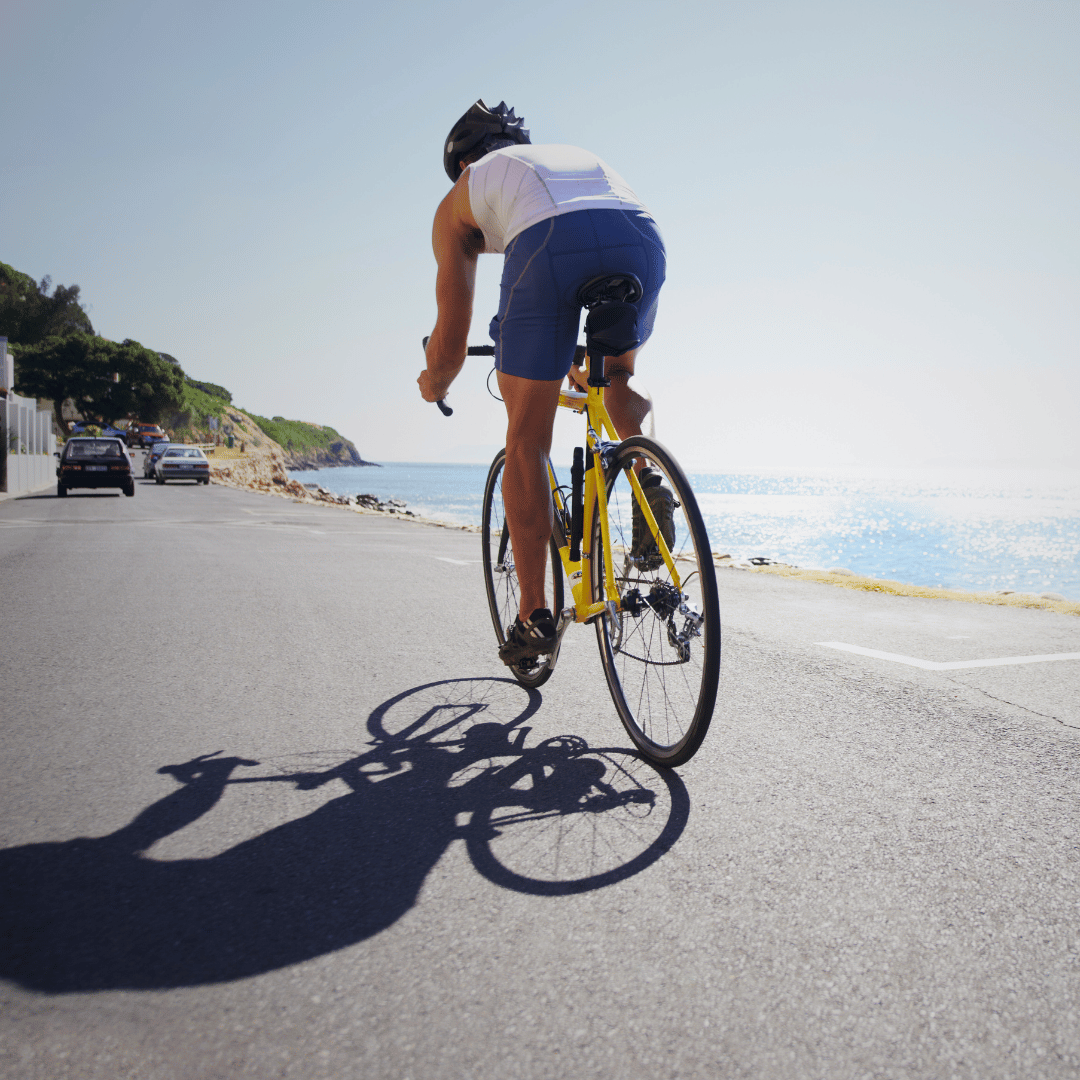
Keep your upper body relaxed and your grip on the handlebars light—focus on loosening up your muscles and not tensing them up. This will help you conserve energy and maintain better control of the bike.
5. Find your rhythm:
Focus on maintaining a steady cadence throughout the climb. This means finding a sustainable pedaling pace without straining too much.
As you climb, keep your pedaling rhythm consistent and avoid sudden bursts of speed or slowing down too much. Pay attention to your breathing and effort level. If you find yourself straining too much or feeling out of breath, it might be a sign to adjust your cadence or shift into an easier gear.
6. Stay seated:
When the climb isn’t too steep or technical, staying seated while climbing is more efficient; it helps maintain traction and conserves energy. Seated climbing allows you to engage your core and pedal with a smoother, more controlled motion.
However, there may be times when standing on the pedals is necessary, such as on steeper sections or when you need to generate extra power if you’re feeling fatigued.
There is no strict rule regarding how often or how long you should stand while cycling. However, many riders find standing for about 30 seconds every few minutes beneficial.
You can also get out of the saddle for 5 minutes in one go. Standing periodically helps to engage different muscles and relieve pressure on certain areas, providing some relief.
To simplify, seated climbing is efficient on gentler climbs. However, aerodynamics matters less when the gradient gets steeper, like above 10%. That’s when standing up can give you an advantage by using your body as leverage for more power.
7. Weight distribution:
When standing up on steep climbs, it’s crucial to distribute your weight properly. The key is maintaining a balanced position, leaning slightly forward while keeping your weight centered over the bike.
For instance, if you encounter a 20 percent climb, which means that for every 100 meters you travel horizontally, the road will rise by 20 meters vertically.
During this, your rear wheel may lose traction if you lean too far forward, especially if the road is wet. On the other hand, if you sit too far back, you risk lifting your front wheel, and doing an unintentional wheeliel.
8. Focus on breathing:
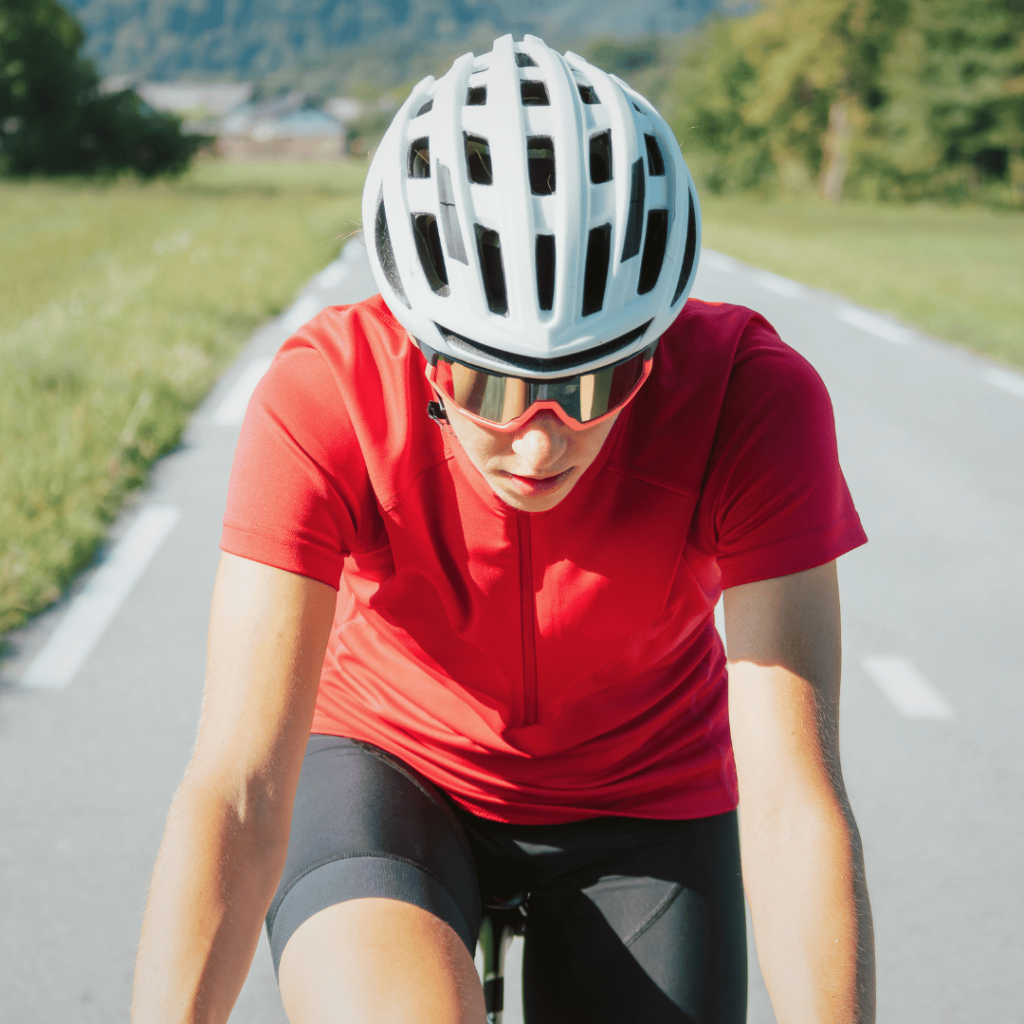
Take deep, controlled breaths to ensure a steady oxygen flow to your muscles. This will help you maintain endurance and prevent fatigue. Your breath should be deep and rhythmic, even if it feels labored. If you find yourself breathing shallowly and rapidly, it’s a sign that you’re pushing beyond a sustainable effort level.
You must aim for a perceived exertion level of around 7-8 out of 10, which means you’re working hard but still able to maintain the pace. On long mountain passes, start at a slightly lower perceived exertion level of 6-7 and gradually increase it as needed.
9 Additional Tips To Climb Faster On A Road Bike:
Now that we know the steps to climb a hill faster on a road bike, I’ve got some great tips for you on how to climb faster on a road bike.
Here are a few tips:
1. Start Strength Training
Strength training is incredibly beneficial for climbing hills. When you engage in strength training exercises, you specifically target and build the muscles crucial for cycling, like your quadriceps, hamstrings, glutes, and core muscles.
To start strength training for faster climbs, you can incorporate a few key exercises, such as squats and lunges. These exercises are great for building lower body strength, which will help you power through those climbs.
You can also incorporate exercises like deadlifts and step-ups to target your glutes and hamstrings. Gradually increase the weight and intensity of your workouts over time to continue challenging your muscles.
Remember to work on your core stability with exercises like planks and Russian twists. Consistency is key!
2. Improve Your VO2 Max And Anaerobic Endurance
Improving your VO2 max and anaerobic endurance is crucial for climbing, as they directly impact your ability to sustain high-intensity efforts for longer periods. VO2 max is the maximum amount of oxygen your body can utilize during intense exercise.
Increasing your VO2 max will enhance your body’s capacity to deliver oxygen to your muscles, allowing them to work harder and more efficiently during climbs. This helps you maintain a higher power output and endurance during those challenging uphill sections.
To increase your VO2 Max, you can do zone 2 training with long rides and shorter hill repeats at 110-125% of your FTP for 3-5 minutes. Try long sprints or efforts greater than 130% of your FTP to improve your anaerobic endurance.
You must also incorporate specific training methods into your cycling routine to increase your VO2 max and anaerobic endurance. High-intensity interval training (HIIT) is a great way to improve both aspects. You alternate between short bursts of intense effort and active recovery periods during HIIT sessions.
This helps push your cardiovascular system to its limits and improves your body’s oxygen use efficiency.
3. Focus On Technique And Cadence
Focusing on technique during hill climbs allows you to maximize your efficiency and conserve energy. Here are a few techniques you can focus on:
- Body Position:
Maintain a balanced and relaxed body position on the bike. Keep your upper body steady and aligned with your bike while slightly leaning forward to distribute your weight evenly.
- Gear Selection:
Use the appropriate gear for the climb. Shift to a lower gear before you start the ascent to ensure that you can maintain a steady cadence without excessive strain on your legs.
- Pacing:
Pace yourself and avoid starting too fast. Finding a sustainable effort level that allows you to maintain a consistent pace throughout the climb is important. Gradually increase your effort if needed, but be mindful of not burning out too soon.
Additionally, it is important to maintain a smooth and steady pedal stroke by keeping your upper body relaxed and your core engaged when climbing and keeping your cadence within a comfortable range.
Cadence, which refers to how fast you pedal, is crucial, especially when tackling steep climbs. Ideally, you’d want to maintain your preferred cadence throughout the climb. For most people, that’s typically between 80 and 90 revolutions per minute (RPM).
Generally, a cadence of around 70-90 revolutions per minute (RPM) is a good target. This allows you to generate power without putting excessive strain on your muscles, helps distribute the workload evenly among your muscles, and prevents early fatigue.
However, when faced with a steep climb like a 15% gradient, it can be challenging to maintain a high cadence of 90 rpm unless you have a cassette with a wide range of gears. That’s where low cadence drills come in handy. By practicing 5-minute blocks at 80% FTP and around 55-60 rpm, you can train your ability to power through steep climbs by grinding a bigger gear.
On the other hand, to maintain focus during hill climbs, focus on your breathing and take deep, controlled breaths to maintain a steady oxygen flow to your muscles. This can help you stay calm and focused.
You must also break it down into smaller segments instead of considering the entire climb. Focus on reaching the next landmark, such as a tree or a bend in the road. By setting mini-goals, you can maintain your focus and stay motivated throughout the climb.
4. Use The Right Gears
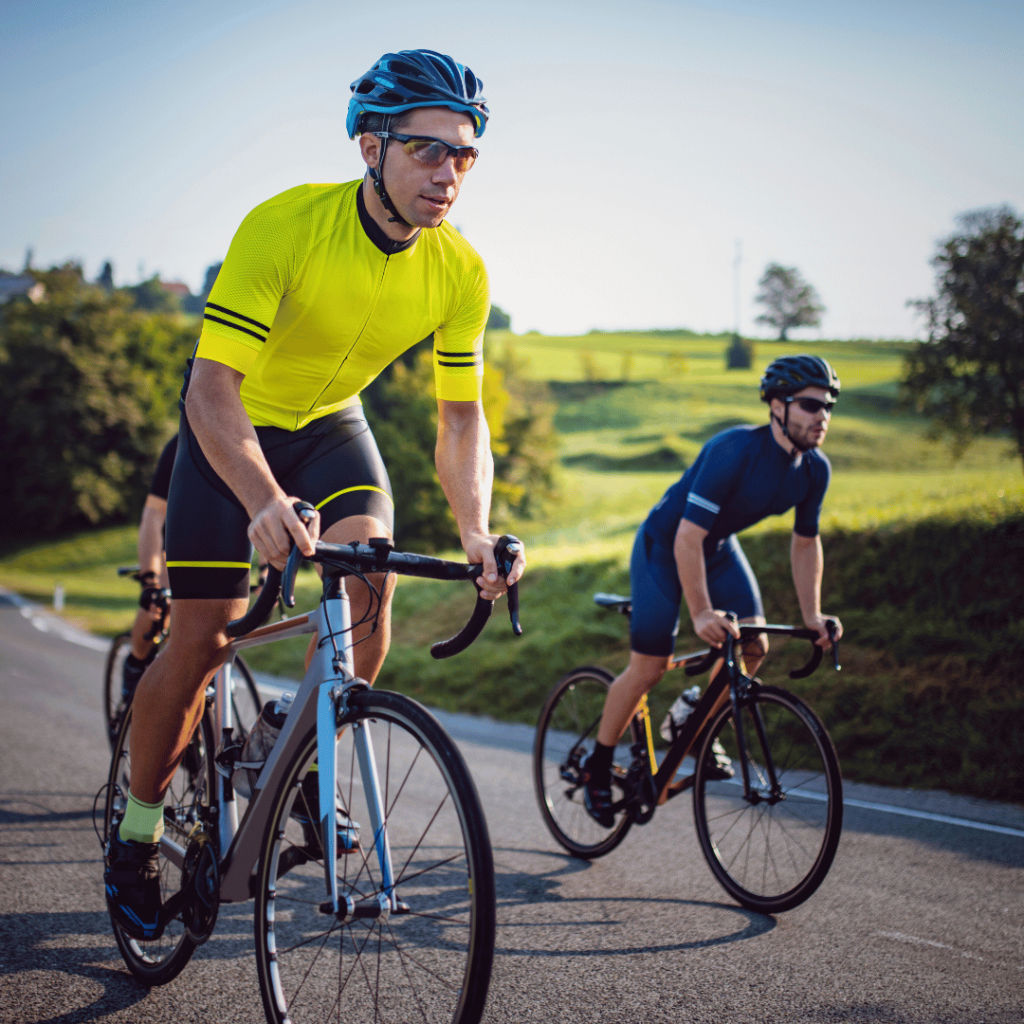
Begin the climb in a lower gear that feels light and allows you to spin your legs comfortably. A common gear combination for climbing hills is using the small chainring in the front (typically the smallest one) and a larger cog in the rear (towards the outer end of the cassette).
This helps you warm up and find your rhythm. If the climb is long, steady, or really steep, shift to the smallest chainring in the front and the largest cog in the back. And, if you know there’s a steep section coming up, shift to an easier gear before you reach it. This way, you’ll be prepared and won’t lose momentum or strain your muscles.
Remember that if you use the wrong gears, pushing on the pedals will be tough, and you’ll waste a lot of energy. And when it comes to choosing the right chainring setup for climbing, there are a few options to consider: The standard setup with a 53 by 39 tooth chainring, a compact setup with a 50×34 tooth chainring, or a semicompact setup at 52 by 36 tooth chainring.
For most riders, unless you’re a pro, a compact or semicompact setup would likely be more beneficial in the long run for the types of climbs you’ll be doing. A compact or semi-compact setup refers to the gear ratios on the chainrings and cassette of a road bike.
- Compact Setup:
A compact setup typically consists of a smaller chainring size (usually 50/34 teeth) paired with a wider range cassette (11-32 teeth). This setup provides lower gears, making climbing steep hills or riding in challenging terrain easier.
- Semi-Compact Setup:
A semi-compact setup falls between a standard and a compact setup. It usually consists of slightly larger chainrings (52/36 teeth) paired with a mid-range cassette (11-28 teeth). This setup offers a good balance between climbing ability and maintaining speed on flatter sections.
Both compact and semi-compact setups are popular for recreational riders and enthusiasts who want versatility in their gear options. They provide a wider range of gears, making it easier to tackle various types of climbs and ride comfortably in different terrains.
Choosing a setup that suits your riding style, fitness level, and the climbs you’ll be doing is important. If you frequently encounter steep or challenging climbs, a compact or semi-compact setup can be more beneficial in the long run. It allows you to maintain a comfortable cadence and tackle those climbs more easily.
5. Give Yourself An Energy Boost
When you consume fast-absorbing carbs like gels, drinks, or energy bars, it usually takes around 15 minutes for your blood sugar levels to reach their peak. These carbs provide a quick energy source that can boost you during your climb.
So, if you eat your fuel, like fast-absorbing carbs, about 15 minutes before starting your climb, you’ll be in a great position with high blood glucose levels.
Caffeine also provides an energy boost before a ride. Research has shown that taking around 3mg of caffeine per kg of body weight can help reduce the rate of perceived exertion and positively impact performance.
6. Get Used To Climbing — Do More Of It
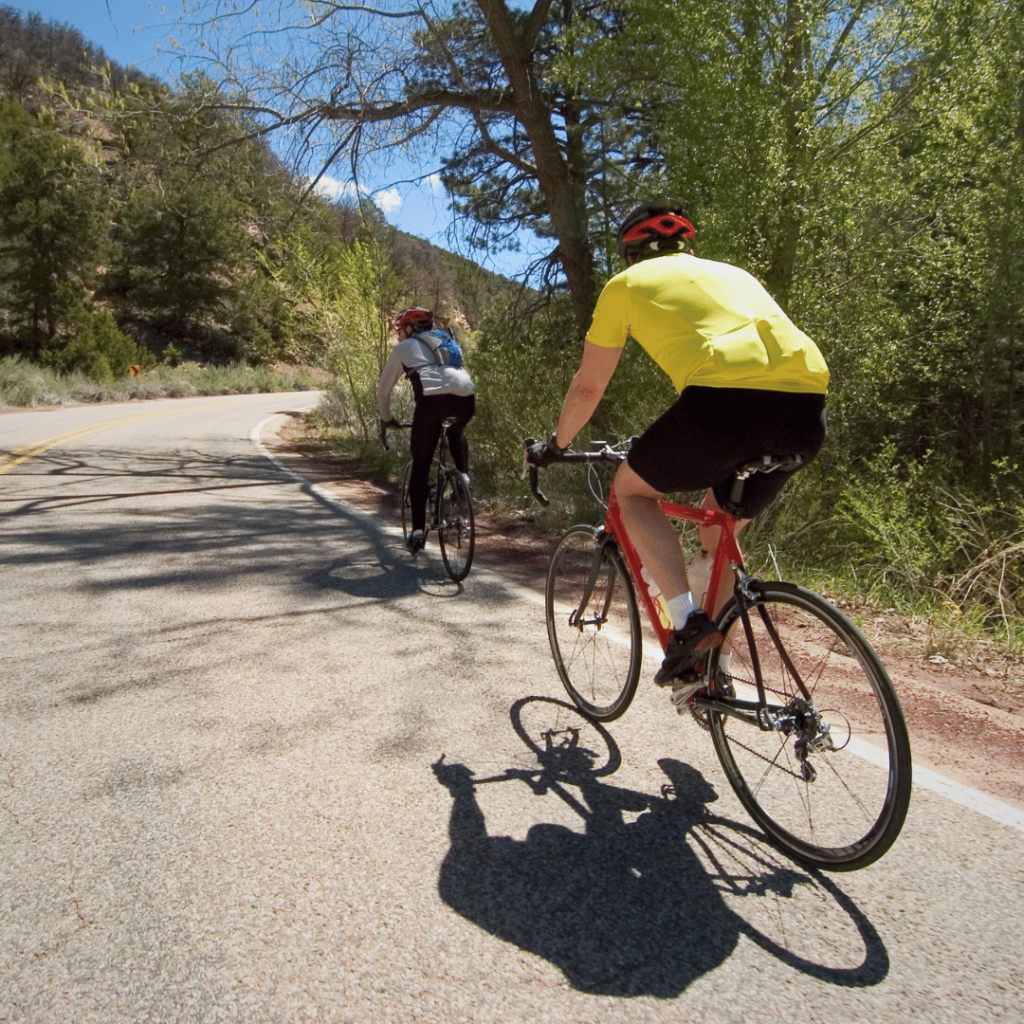
Getting used to climbing by doing more of it is a great way to improve your climbing skills. The more you practice, the more your body adapts to the demands of uphill riding. Your muscles become stronger, your cardiovascular fitness improves, and your body becomes more efficient at tackling those climbs.
Incorporate regular hill workouts such as Hill repeats, long climbs, steep climbs, and interval training into your training rides, seeking out challenging climbs in your area. This will help build your strength, endurance, and climbing skills over time. Remember to start with shorter climbs and gradually increase the difficulty as you progress.
Additionally, by doing more climbs, you become more familiar with different types of terrain, gradients, and challenges that you may encounter during rides. This experience helps you develop strategies, pacing techniques, and mental toughness to overcome any climbing obstacle.
7. Perform Hill Repeats
Hill repeats are a type of training where you ride up a hill multiple times. You start at the bottom, pedal your way up to the top, and then ride back down to the starting point. You repeat this process several times during a workout. It’s a great way to improve your climbing strength and endurance.
It also helps build leg strength and power, which is essential for climbing. The resistance provided by the incline forces your muscles to work harder, leading to increased strength and improved overall climbing performance.
Additionally, climbing requires sustained effort over an extended period. So, hill repeats help improve your endurance by pushing your cardiovascular system to adapt to climbing demands.
Here are a few examples of hill repeats that you can incorporate into your cycling training:
- Short Hill Repeats:
Find a relatively steep hill that takes 30-60 seconds to climb. Ride up the hill at a high intensity, focusing on maintaining good form and a consistent cadence. Descend the hill and repeat the effort for a set number of repetitions, gradually increasing the number as you get stronger.
- Long Hill Repeats:
Look for a longer climb that takes around 3-5 minutes to complete. Ride up the hill sustainably, aiming to maintain a steady pace throughout. Descend the hill and repeat the effort for a set number of repetitions, gradually increasing the number as your fitness improves.
- Pyramid Hill Repeats:
Start with a shorter hill and complete a set of repeats, gradually increasing the number of repetitions. Then, move on to a longer hill and decrease the number of repetitions accordingly. This pyramid structure helps you build both speed and endurance.
- Rolling Hill Repeats:
Find a route with a series of rolling hills. Ride high intensity on the uphill sections, focusing on maintaining a consistent effort. Use the downhill sections for recovery. Repeat this pattern for a set duration or distance.
8. Add variety to your training
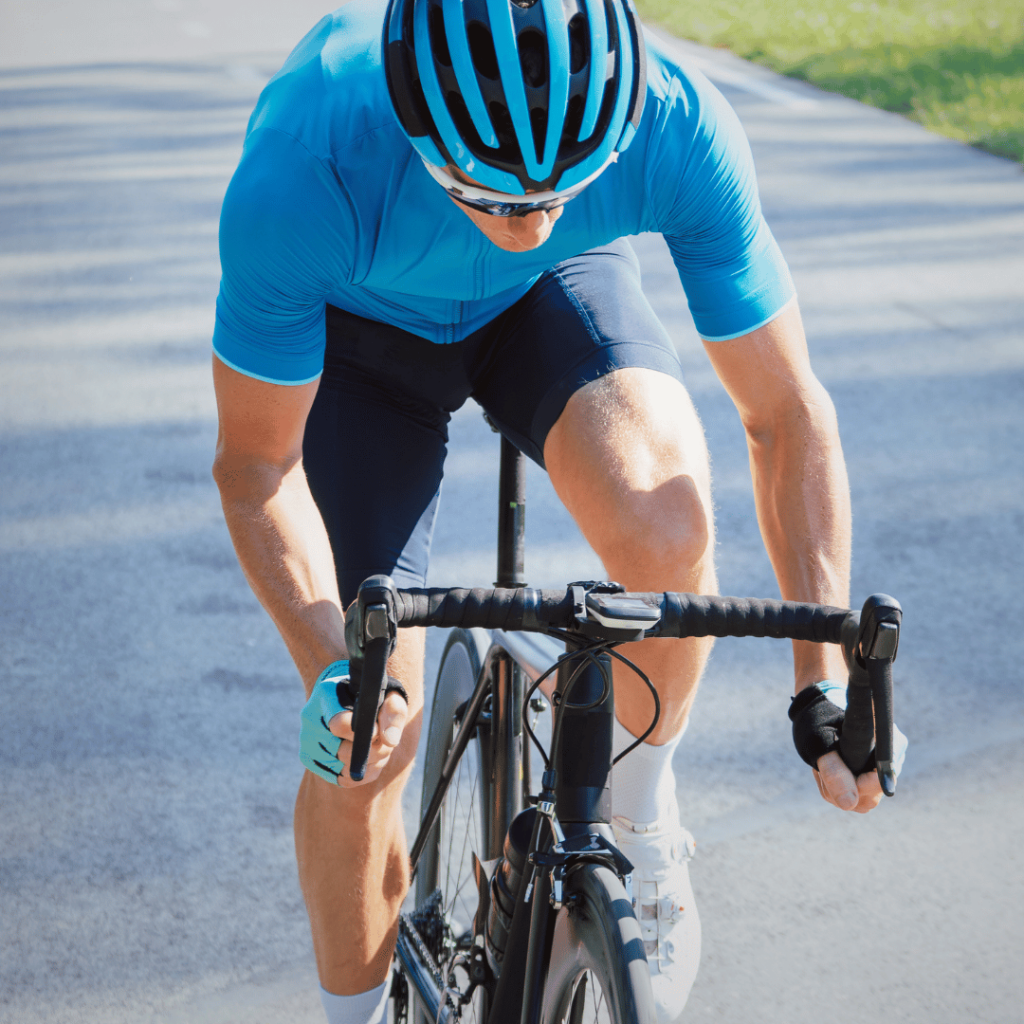
When you repeatedly do the same type of climb or workout, your muscles can become accustomed to the specific demands, leading to a plateau in performance. By introducing variety in your training, such as different types of climbs, intervals, or cadence variations, you challenge your muscles in new ways and promote continued improvement.
For example, practicing climbing on steep gradients will improve your ability to maintain a steady cadence and power output, while incorporating rolling hills can help you work on your transitions between climbing and descending.
Additionally, by incorporating a variety of climbs, you can work on different aspects of your fitness. Steep climbs focus on strength and power, while longer, sustained climbs improve endurance. Mixing up your training allows you to develop a well-rounded fitness profile and be prepared for a wider range of riding conditions.
Here are a few ways to mix it up:
- Interval Training:
Incorporate high-intensity intervals into your rides. This involves alternating between periods of intense effort and recovery. It helps improve cardiovascular fitness and increase your ability to sustain higher speeds.
- Hill Repeats:
Find a challenging hill and do repeated climbs. This helps build strength and endurance in your leg muscles and prepares you for climbing steep inclines.
- Long Endurance Rides:
Go for longer rides at a moderate pace. This helps build your aerobic capacity and improves your ability to sustain effort over extended periods.
- Tempo Rides:
Ride at a steady, challenging pace for an extended period. This helps improve your lactate threshold and increases your ability to sustain a hard effort.
- Group Rides:
Join group rides to experience different riding styles, learn from others, and challenge yourself by riding with people of varying abilities.
- Cross-Training:
Incorporate other forms of exercise, such as strength training, yoga, or swimming, to work on different muscle groups and improve overall fitness.
9. Prioritise Training Your Core
A strong core provides climbing stability and balance. It helps you maintain a steady posture on the bike, especially when you’re out of the saddle, tackling steep gradients, or navigating technical terrain.
Here are a few examples of core exercises you can incorporate into your training routine:
- Planks:
Get into a push-up position with your elbows on the ground, and hold your body in a straight line for 30-60 seconds.
- Russian Twists:
Sit on the ground with your knees bent, lean back slightly, and twist your torso from side to side while holding a weight or medicine ball.
- Bicycle Crunches:
Lie on your back, bring your knees up, and mimic a pedaling motion while touching your elbow to the opposite knee.
- Superman Holds:
Lie face down on the ground, extend your arms and legs, and lift them off the ground simultaneously, holding for 10-15 seconds.
- Side Planks:
Lie on your side, supporting your body with one forearm, and hold a straight line from head to toe for 30-60 seconds.
Remember that a stable core allows you to transfer power efficiently to the pedals, improving your climbing performance. It links your upper and lower body, enabling you to generate more force and maintain a consistent cadence. This efficient power transfer translates into improved climbing speed and endurance.
Additionally, climbing can put strain on various parts of your body, including your lower back. A strong core helps stabilize your spine and pelvis, reducing the risk of lower back pain or injury. It also supports proper body mechanics, distributing the workload evenly and minimizing stress on other muscles and joints.
Proper Body Positions While Climbing Hills
Seated:
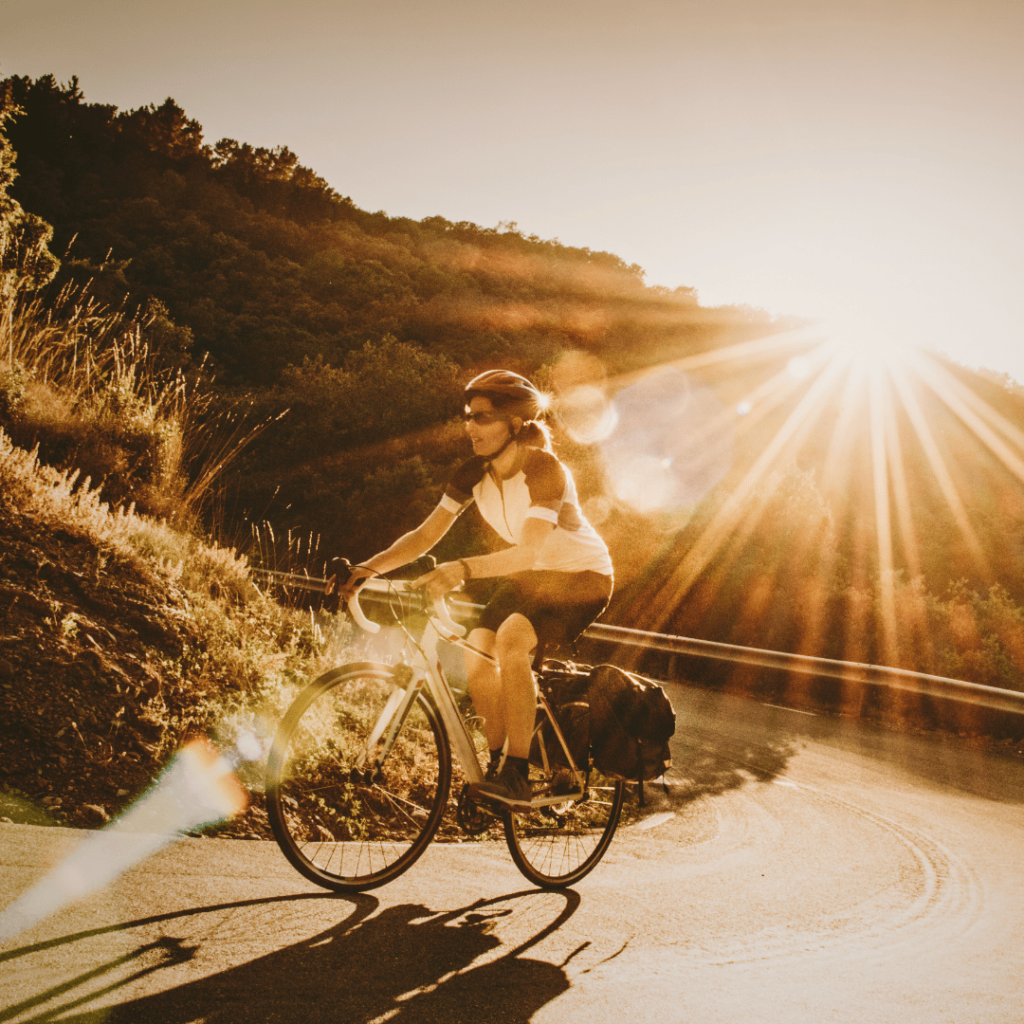
You must stay seated on your bike to maximize power output and maintain a high pedaling cadence. By staying seated, you can engage your glutes and leg muscles more efficiently, allowing you to generate more power with each pedal stroke. Also, maintaining a high cadence (the number of pedal revolutions per minute) helps you maintain momentum and reduces muscle strain.
The sweet spot for efficiency is typically between 70 to 90 revolutions per minute. If you need more power:
- Drive your rear end to the back of your seat as you push on the downstroke.
- Lean forward.
- Keep your elbows flexed, but pull on the handlebar opposite your downstroke leg. This helps you use your gluteal and leg muscles.
Standing:
Sometimes, the hills can get super steep, and you need that extra power to conquer them. In those situations, standing up on your pedals is helpful, as you use your body weight to generate more force.
- Lean the bike away from the foot as you begin the downward stroke.
- Keep your body in a straight line over the weighted foot.
- Lean forward on the handlebars to deliver even more power, but keep your elbows loose.
- Transfer your weight to the other foot as the weighted foot finishes its stroke.
- Use the bike as a lever to help pull your weight over to the other foot. The bike should lean toward the unweighted foot, and your body should be in a straight line above the weighted foot.
Conclusion:
Climbing faster on your road bike is about finding the right balance between power, technique, and strategy. Remember to stay consistent with your training, listen to your body, and enjoy the journey as you push yourself to new heights.
This blog post provides valuable insights and practical tips for enhancing your climbing abilities on a road bike. Try them and see how they work for you!
Happy cycling!
Frequently asked Questions:
1. Do I need a specific bike for climbing hills?
No, you don’t necessarily need a specific bike for climbing hills. While there are bikes designed specifically for climbing, such as lightweight road bikes with gearing optimized for steep gradients, you can still climb hills effectively with all bike types.
2. How can I conquer steep hills without getting exhausted?
One effective strategy is to focus on your breathing. Take deep breaths and exhale fully to supply your muscles with oxygen. Additionally, pacing yourself by finding a comfortable rhythm and using shorter bursts of power can help conserve energy during the climb.
3. Is climbing harder than descending on a road bike?
Climbing and descending have their unique challenges, and they can vary from person to person. While climbing requires more physical effort and endurance, descending can be mentally demanding as you must maintain control and navigate the terrain.
Some cyclists find climbing harder due to the sustained effort and gravity working against them, while others may find descending more challenging due to the higher speeds and technical skills required.
4. What was the average ascending speed of riders in Tour De France?
The average ascending speed in the Tour de France can vary depending on factors like the gradient of the climb, weather conditions, and the stage of the race.
However, professional cyclists in the Tour de France can often maintain impressive speeds while climbing, ranging from 20 to 25 kilometers per hour (12 to 15 miles per hour) on average.

